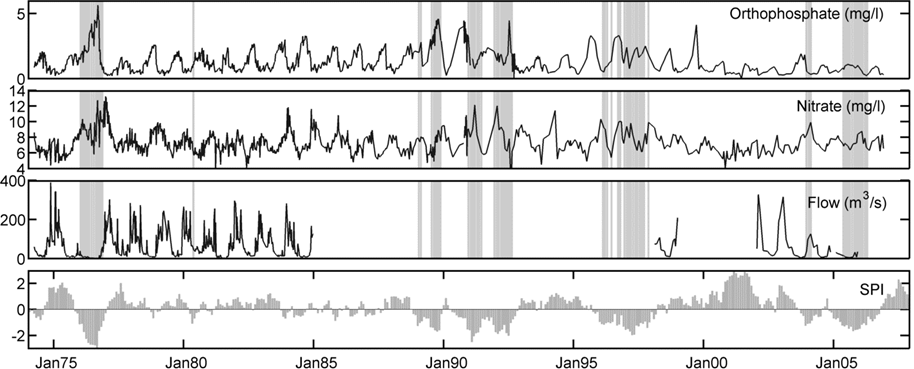Key science findings or outputs
- National scale data analysis of the impacts of drought on water quality in UK rivers
- Development of an end member mixing model for the simulation and prediction of nitrate and phosphorus concentrations in rivers at the national scale
Introduction
NERC’s MaRIUS (Managing the Risks, Impacts and Uncertainties of drought and water Scarcity) project explores how best to manage future droughts in the UK. Work package B4 aims to assess the impacts of drought on water quality in rivers and reservoirs. At the national scale, this will be achieved by, a) analysing extensive data sets to build a picture of how water quality is impacted during drought periods and b) developing an end member mixing model integrated with the national scale hydrological model (dynamic TOPMODEL) from B3 for the prediction of nitrate and phosphorus concentration at the national scale.
Research methods
A range of data analysis and modelling techniques will be used in conjunction to assess the impacts of drought on water quality.
- Analysis of several key water quality parameters across 200 UK sites during several major UK droughts. These data will be used in conjunction with information on catchment characteristics and knowledge of anthropogenic influences in the river.
- Simulation of nitrogen and phosphorus concentrations at the national scale using an end member mixing model which is coupled to the national scale hydrological model.
- Evaluation of national scale water quality in response to the drought event set developed in B1.
National scale data analysis of the impact of droughts on water quality in UK rivers
Understanding the impacts of droughts on water quality in freshwater systems is essential to manage ecosystems and maintain public water supply. During periods of drought, river water quality can be significantly changed due to increased residence times, reduced dilution and enhanced biogeochemical processes. However, the severity of these impacts will vary significantly between catchments and will depend on multiple factors including the sensitivity of the river to drought conditions, anthropogenic influences in the catchment and different delivery patterns of key nutrient, contaminant and mineral sources. To better understand the key driving processes that impact water quality during drought an extensive national scale water quality monitoring data set (the Harmonised Monitoring Scheme dataset) is analysed to investigate the impacts of drought periods on water quality at over 200 UK sites. These data are analysed to investigate how water quality during droughts differs from non-drought periods for different catchments, drought periods and several water quality parameters.

Development of an end member mixing model for the simulation and prediction of nitrate and phosphorus concentrations in rivers at the national scale
For the research in MaRIUS, an end-member mixing model is developed for the simulation and prediction of nitrate and phosphorus concentration in rivers across the UK. The EMM model is coupled to the national scale hydrological model developed in B3 (dynamic TOPMODEL), whereby a concentration of nutrient is hypothesised in each of the flow components provided by dynamic TOPMODEL (direct runoff, soil water and groundwater). Different model conceptualisations will be tested to deduce the key driving processes during drought and uncertainty in the EMM parameters and flow contributions will also be evaluated. The model will be used to assess the current and future impact of droughts on water quality within a probabilistic framework.






